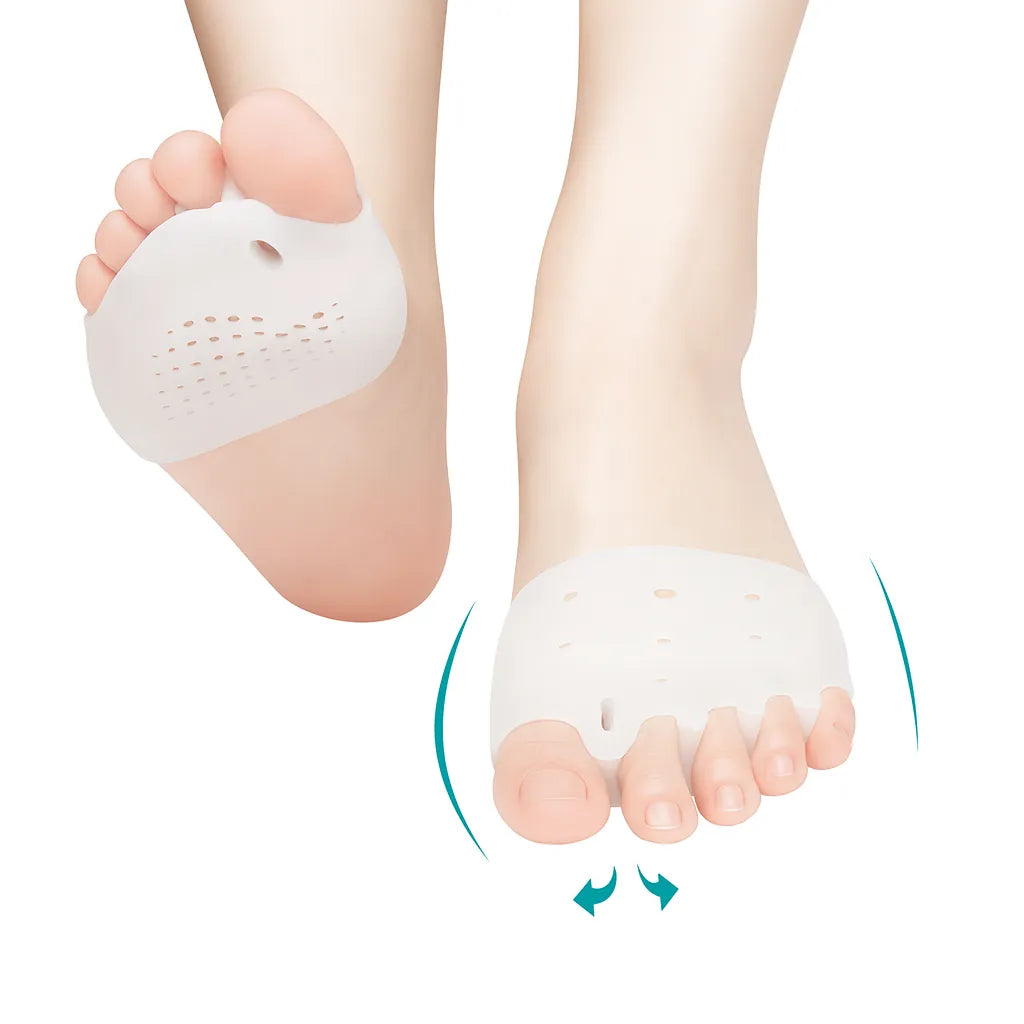
Understanding Plantar Fasciitis And Its Pain Symptoms
Share
Plantar fasciitis is a common condition that affects many individuals, causing discomfort and pain in the foot. This article aims to explore the various aspects of plantar fasciitis, including its causes, symptoms, and treatment options. By understanding this condition, its associated pain and other symptoms, individuals can seek appropriate care and find relief from their discomfort.
What is Plantar Fasciitis (PF)?
Plantar fasciitis refers to the inflammation, and possible rupture, of the plantar fascia - a thick band of connective tissue that runs along the bottom of the foot. The plantar fascia connects the heel bone to the toes and supports the arch of the foot. When this tissue becomes inflamed or irritated, it can lead to intense pain in the heel or bottom of the foot, especially in those first steps of the day.
The Anatomy of the Foot
To understand the impact of plantar fasciitis, it is essential to have a basic understanding of foot anatomy. The foot consists of many intricate structures, including bones, muscles, ligaments, and tendons. Each of these components works together to provide stability, flexibility, and support for the body.
Within the foot, there are 26 bones, which are divided into three main sections: the hindfoot, the midfoot, and the forefoot. The hindfoot is composed of the heel bone, known as the calcaneus, and the talus bone. The midfoot includes five tarsal bones, which form the arch of the foot. Finally, the forefoot consists of the metatarsal bones and the phalanges, which make up the toes.

In addition to bones, the foot also contains numerous muscles that allow for movement and stability. These muscles are divided into two groups: extrinsic muscles, which originate in the leg and extend into the foot, and intrinsic muscles, which are located entirely within the foot. The extrinsic muscles control larger movements, such as flexing, extending and and rotating the foot, while the intrinsic muscles help maintain the arch and provide finer control, especially when we feel unbalanced.
Ligaments and tendons also play a crucial role in foot anatomy. Ligaments are strong bands of connective tissue that connect bones to each other, providing stability and preventing excessive movement. It is common that these get loose and weaker after an ankle sprain, providing less stability to our foot. Tendons, on the other hand, connect muscles to bones, allowing for movement and transmitting the force generated by the muscles.
One of the most important structures in the foot is the plantar fascia. This thick band of tissue runs along the sole of the foot, from the heel bone to the base of the toes. It acts as a shock absorber, supporting the arch of the foot and assisting in the propulsion of the body during activities such as walking, jumping or running.
Causes of Plantar Fasciitis
Plantar fasciitis can develop from various factors, including repetitive strain on the foot, improper footwear, overuse, foot mechanics, and certain medical conditions. Understanding the causes of plantar fasciitis is crucial in preventing its onset or recurrence.
One common cause of plantar fasciitis is repetitive strain on the foot. Activities that involve repetitive movements, such as running, jumping, or dancing, can put excessive stress on the plantar fascia, leading to inflammation and pain. Similarly, occupations that require prolonged standing or walking on hard surfaces can also contribute to the development of plantar fasciitis.
Improper footwear is another significant factor in the development of plantar fasciitis. Shoes that lack proper arch support or cushioning can place additional strain on the plantar fascia, leading to irritation and inflammation. High heels, for example, can alter the natural alignment of the foot and increase the risk of developing this condition.
Foot mechanics also play a role in the development of plantar fasciitis. Individuals with flat feet or high foot arches may be more prone to developing PF. Flat feet can cause the plantar fascia to stretch excessively, while high arches can lead to increased tension on the fascia. Additionally, tight calf muscles can contribute to plantar fasciitis by also placing additional stress on the plantar fascia.
Certain medical conditions can increase the risk of developing plantar fasciitis as well. Obesity, for example, can put extra pressure on the feet, increasing the strain on the plantar fascia. Other conditions, such as rheumatoid arthritis or diabetes, can also contribute to the development of plantar fasciitis due to the diminished capacity of the body to heal.
Identifying and addressing the underlying causes of plantar fasciitis is crucial in managing the condition and preventing its recurrence. By understanding the anatomy of the foot and the factors that contribute to plantar fasciitis, individuals can take proactive steps to protect their feet and maintain optimal foot health.
Recognizing the Symptoms of Plantar Fasciitis
Ideally, you should make sure that you eliminate any potential cause for plantar fasciitis, as it was mentioned before. However, when it does happen, identifying its symptoms is crucial for early intervention and management. By recognizing the signs, individuals can seek appropriate treatment and prevent the condition from worsening.
Plantar fasciitis is a common foot condition that occurs when the plantar fascia, a thick band of tissue that runs along the bottom of the foot, becomes inflamed or even ruptures. This inflammation can cause pain and discomfort, making it important to recognize and correct the possible causes.
Common Signs and Symptoms
Plantar fasciitis often presents with a sharp, stabbing pain in the heel or arch of the foot, especially during the first steps in the morning or after prolonged periods of rest. The pain may subside or improve with movement, but it can return after prolonged activity or standing, being commonly present at the end of the day.
In addition to pain, individuals with plantar fasciitis may also experience other symptoms. Swelling, tenderness, or redness in the affected area are common signs that the plantar fascia is inflamed. These symptoms can make it difficult to walk or engage in physical activities, affecting daily life.
Severity and Duration of Pain
The severity of plantar fasciitis pain can vary from person to person. While some individuals may experience mild discomfort, others may have intense pain that hinders their daily activities. The pain can be described as a sharp, shooting sensation or a dull ache that persists throughout the day.
Without proper treatment, the symptoms of plantar fasciitis can persist for several months or even years. This chronic condition can significantly impact an individual's quality of life, making it important to seek medical attention as soon as symptoms arise.

It is important to note that plantar fasciitis can affect anyone, but certain factors may increase the risk. These include obesity, high-impact activities, improper footwear, and foot mechanics. Understanding these risk factors can help individuals take preventive measures and reduce the likelihood of developing or prolonging plantar fasciitis.
In conclusion, recognizing the symptoms of plantar fasciitis is essential for early intervention and management. By understanding the common signs and severity of pain associated with this condition, individuals can seek appropriate treatment and prevent further complications. It is important to consult with a healthcare professional for an accurate diagnosis and personalized treatment plan.
The Science Behind Plantar Fasciitis Pain
Understanding the underlying mechanisms of plantar fasciitis pain can provide valuable insights into effective treatment approaches. While the exact cause of pain is not fully understood, there are certain factors that contribute to the discomfort experienced by individuals with plantar fasciitis.
Inflammation and Heel Pain
Inflammation plays a significant role in the development of plantar fasciitis pain. When the plantar fascia becomes irritated, the body's immune response triggers an inflammatory reaction, resulting in swelling, redness, and pain. It is important to address the underlying inflammation to alleviate the symptoms and promote healing.
The plantar fascia is responsible for absorbing shock and supporting the arch of the foot. When excessive strain is placed on this structure, micro-tears can develop, leading to inflammation and consequently pain.
Diagnosis of Plantar Fasciitis
Diagnosing plantar fasciitis typically involves a comprehensive evaluation by a healthcare professional. By assessing the individual's medical history, conducting a physical examination, and utilizing imaging tests, a proper diagnosis can be made.
Medical History and Physical Examination
During the initial consultation, the healthcare professional may inquire about the individual's symptoms, activity level, footwear, and any previous injuries or medical conditions. This information, combined with a physical examination of the foot and overall static and dynamic posture, can help determine the likelihood of plantar fasciitis and rule out other potential causes of foot pain.
Imaging Tests for Confirmation
In some cases, imaging tests such as X-rays or ultrasound may be recommended to confirm the diagnosis and evaluate the extent of tissue damage or inflammation. These tests can provide valuable insights into the severity of the condition and guide the treatment plan and duration.
Treatment Options for Plantar Fasciitis
Effective treatment options for plantar fasciitis aim to alleviate pain, reduce inflammation, promote healing, and prevent recurrence. Multiple approaches can be utilized, depending on the severity and individual needs.
Non-Surgical Treatments
Non-surgical treatment options are usually explored initially and may include rest, ice therapy, physical therapy exercises and techniques (mobilization and massage), stretching, proper footwear, orthotic devices, and medications to manage pain and inflammation. These conservative measures are often successful in providing relief and promoting healing.
Surgical and Other Procedures
In rare cases where non-surgical treatments fail to provide adequate relief, surgical intervention may be considered. Surgical procedures for plantar fasciitis aim to release tension on the plantar fascia, remove any scar tissue, and promote healing. Other minimally invasive procedures, such as extracorporeal shockwave therapy or platelet-rich plasma injections, may also be utilized.
By understanding the intricacies of plantar fasciitis and its associated pain symptoms, individuals can take proactive steps towards prevention, seek appropriate care, and find relief. It is important to consult a healthcare professional for a proper diagnosis and to develop a personalized treatment plan catered to individual needs. With the right approach, individuals can minimize the impact of plantar fasciitis on their daily lives and restore their overall foot health.
Author Bio

Inês Pinheiro
Certified Physiotherapist for Shoulder and Knee Injuries
Inês is a skilled physical therapist with a special interest and extensive experience in working with athletes, specifically football players and also neurologic patients.













